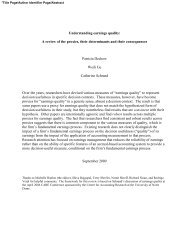Nintendo's “Revolution” - MIT Sloan School of Management
Nintendo's “Revolution” - MIT Sloan School of Management
Nintendo's “Revolution” - MIT Sloan School of Management
You also want an ePaper? Increase the reach of your titles
YUMPU automatically turns print PDFs into web optimized ePapers that Google loves.
NINTENDO’S “REVOLUTION”<br />
Sangbeom Kim, Ian Lamont, Hiroshi Ogasawara, Mansoo Park, Hiroaki Takaoka<br />
Nintendo wasn’t the only company to pr<strong>of</strong>it. Several American game studios grew very successful<br />
businesses creating games using the Nintendo model until lawsuits from shut out developers and an<br />
antitrust investigation forced Nintendo to discontinue exclusivity requirements. 16 Nevertheless, the<br />
third-party developer model was established as an extremely pr<strong>of</strong>itable and effective way to sell<br />
games — and consoles.<br />
A Technological Arms Race<br />
Nintendo began to face strong competition from Tokyo-based Sega, which released a 16-bit console<br />
called Genesis in 1989. There was also growing competition from PC games, including new roleplaying<br />
titles such as Ultima, which took advantage <strong>of</strong> rapid advances in semiconductor technology as<br />
well as the huge distributed base <strong>of</strong> PCs running on Micros<strong>of</strong>t Windows. Additional PC technology<br />
enablers included 256-color VGA graphics cards and “Sound Blaster” cards for audio.<br />
Increasingly, games and game consoles began to compete on underlying technological advancements,<br />
enabled by exponential advances in computing technology. Blocky 2D graphics and limited sound<br />
effects had been replaced by slick 3D environments, stereo audio, and even high-quality CGI<br />
“cutscenes” that featured the voices <strong>of</strong> actors recorded in pr<strong>of</strong>essional sound studios.<br />
Even though the modern consoles were roughly the same size as their late-1970s counterparts, the<br />
hardware inside the machines had drastically changed. A video game console was essentially a<br />
computer with a niche purpose: letting users play games. Just like PCs and all other computers, video<br />
game consoles had a central processing unit (CPU), which carried out the various processing<br />
functions necessary to play games, including starting a new game, loading a new level, calculating<br />
scores, processing inputs from the controllers, and displaying the results on the screen. The power <strong>of</strong><br />
early console processors was measured in “bits,” or a binary digit (one or zero). The Atari 2600 had a<br />
4-bit CPU, while the consoles <strong>of</strong> the late 1990s used faster 64-bit CPUs.<br />
Modern consoles had an additional component, as well: graphics processing units (GPU), also known<br />
as graphics accelerators. A GPU was an extra processor that allowed the CPU to <strong>of</strong>fload calculations<br />
and instructions required to render graphics on the screen. With powerful CPUs, GPUs, and sound<br />
cards, consoles could deliver more intense gaming experiences, including more realistic textures,<br />
weapons, backgrounds, characters, and monsters in 3D worlds.<br />
Diversification in the 1990s<br />
As the hardware race heated up, Nintendo and Sega continued developing consoles. A second<br />
Nintendo console, the Super Famicom, or Super NES, was launched in the early 1990s and sold 49<br />
16 L. Gordon Crovitz, “Rule <strong>of</strong> Congress Zaps Mario and Luigi With Killer Lawyers,” The Wall Street Journal, January 17, 1990.<br />
October 18, 2011 4
















